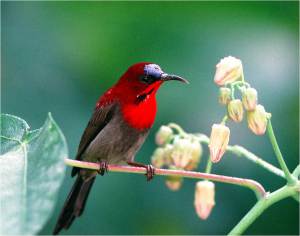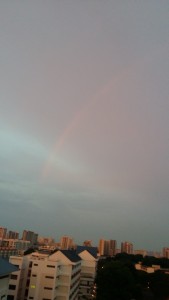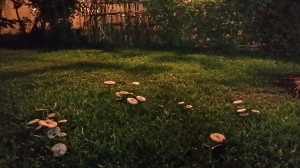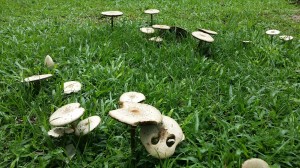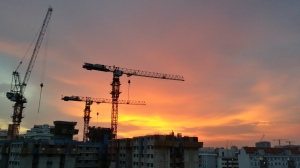Crimson Sunbird is now the official National Bird of Singapore.
Crimson Sunbird. This was the photo used for the voting of the National Bird in 2002.
It is official, the Crimson Sunbird,Aethopyga siparaja has been declared the National Bird of Singapore by Dr. Shawn Lum, President of the Nature Society (Singapore) at the 6th Asian Bird Fair Fellowship Dinner at the Quality Hotel Marlow on the 31st October 2015. He also declared the Common Rose as the National Butterfly of Singapore.
On 25th May 2002, the public was invited to vote for the National Bird of Singapore at the Nature Society (Singapore) 1st Nature Day at Parco Bugis Junction. Out of a total of 1,038 persons who voted at the 3 days event, the Crimson Sunbird came up tops with 400 votes ( 38%). The White-bellied Sea-eagle was second with 236 votes, Black-naped Oriole with 200 , Olive-backed Sunbird with 157 and the Greater-Racket-tailed Drongo with 45 votes.
The…
View original post 106 more words
I Remember September
The Sky – a shade of sickly grey
the (Crescent) sliver crimson,
the nose of peat and breath of ley
from Mother Earth arisen
Her day-old hatchlings drawn to sea,
Her silver moths to slaughter; flame
consumes Her Primaries angrily –
our silent sinking Grand Old Dame
She screams a crackling frequency
but soft, so i remember
last time in April, May, or June,
this time, (damn me), September
and what lies dank beneath the burnt,
repeated, carbon, chemistry,
and what, indeed, has mankind learnt
from this rekindling history?
Concert Review: Pianissimo, Quiescence, Requiem, Scherzo, Trio
Pianoforte Lim Yan
Violin Lee Shi Mei
Cello Lin Juan
30 Sep 2015 . Sat
Esplanade Recital Studio
Beethoven “Kakadu” Variations
Shostakovich Piano Trio No. 2
Schubert’s B-Flat Piano Trio
In a preview (if you will) of their 9 Oct performance as part of the inaugural 2015 Singapore International Festival of Music, this combination featuring local stalwarts and an expansive program was embraced by a conservative turnout on this Wednesday evening. Despite the modest, albeit loyal, audience, the trio shone in their debut(?) collaboration and crafted several magical moments within these two short hours.
First up would be the variations on a then-popular theme “Ich bin der Schneider Kakadu” (Eng: “I am Mr Cockatoo”). A fairly lightweight and now-forgotten tune, it was likely composed much earlier in Beethoven’s career then subsequently revised into a much more robust set. A critic noted it’s lack of unity, but what it lacks in cohesiveness it makes up in breadth of scope. From the gravity of the slow introduction, to the classical levity of the main body of variations, to the fugal retrospection of the later sections, the trio took all challenges in their stride, with only the slightest hint of a disagreement of momentum with the cello opting to push the pulse and the violin preferring giving the phrases full value of lyricism. Apart from a sprinkling of clearly tricky sections (that other ensembles also appear to have trouble with), there was little left wanting from the trio’s experienced prowess moving from molten sound to articulate aristocracy.
The anchor work of the evening would not be the titular one, intriguingly enough. Dedicated to his good friend Ivan Sollertinsky, Shostakovich’s second attempt at the medium would a devastating portrait of both statistical and individual tragedy; in comparison, the first was a student work of romanticism and relative lyrical beauty. A haunting and deceptively (read: terrifyingly) difficult cello solo of harmonics set the opening otherworldly atmosphere, within which an endless, fruitless search ending in dissonant dead-ends seems to take place throughout the first movement. An exuberant, almost manic Scherzo, played to nail-biting intensity without any sacrifice in line-building, swung bipolar from consonance to dissonance in both major and minor modes. Following trudgingly, the semi-fugal Largo began to display the trio’s uncanny blended ensemble soundscape, leading attaca to the blazing finale reminiscent of the famous movement in his 8th string quartet.
As dessert to cleanse the palate of the gravitas, the Schubert was certainly the sunny finale of the evening to look forward to. Semi-repetitive but not yet to a fault, the sweet melodies were distributed simply (not finely woven) through the three musicians, and were executed to an exquisite precision of rhythm and musicianship. The coalescence of magic arrived in the Andante, when that legendary moment when that every ensemble seeks manifested, and the trio sounded as one organism, one pulse, one multi-threaded line. A dainty Scherzo-Trio and a devilishly-dotted Rondo later, the trio wrapped up this neat package of brilliance and dulcitude.
Looking forward to yet another successful concert on the 9th of October, and to many more successful and creative collaboration from this promising group in the future.
Additional review of Shostakovich’s Piano Trio #2 and Piano Quintet in G Minor
I remember May when September comes
A decade and a half, a younger me,
One so naive and silly,
Thought hard of voting for my chairman
from a candidate pool of one
chosen by my instructor-in-charge –
I thought it was great fun.
A decade, a teenager me,
finding my place in JC
Told to vote for my chairman
by my deskmate, (a desk has two)
One year hence another asked (the air)
“why did I vote for you?”
Then half a decade hence, and I
remember May nights chocolate skies
Torn between the exams of the day
and sentiments of night.
Why did I have to decide
against something that was my right?
Now there lays just half a day
till, for Parliament, I’ll have a say
Taken to task for choosing fair
for jobs, for roads, for covered walkways new.
Do I have the answer now,
to my forebears, fellows – to my heirs?
I Remember July
fifty vehicles,
ten black ribbons, three red balls.
one red-and-white flag
I remember heat
I remember July, (June?)
I remember peace;
I remember thinking hard,
I remember haze
society tries out
nuclear option on a child,
and a discharged nurse.
We Remember June
June was a time of me, myself, and I
remember June for all the joy it brought to you and me
for all that comes before is hopes of holiday,
hopes of freedom, flight, rejuvenation
We remember June now that we remember nature –
she who giveth us life taketh it like the
heavens taketh water, and giveth us ice;
as the sun gives us gold and the moon silver –
and only silver may man wield over another’s tomb
and only earth (from whence we came) may take us once again.
I Remember April
I remember the weather like I remember
April – the arid,
no, humid,
stagnation of warm,
steaming, summer. Not that we have seasons.
Not that we have much to mark our calendars with in April, (April Fool’s perhaps?)
or maybe this year’s seasonal Friday – after all, it Was Good.
Sometimes the skies take to storm, and the two-minute rainbow that follows after the
distant thunder-anvil mirrors the oily, imperceptible, impenetrable sheen that one can barely call
sunset.
Sometimes the lands take to flame, and when there is fire
there is smoke, not always visible smoke, but sometimes as visible as a sunset that arrives unannounced,
touching the tip of the senses just as a scent does upon half-waking.
Sleep is all that is interrupted in summer, slow-cooking in the evening, searing in the noon, the Sun
rules over the dainty Earth and all she does is bow,
ever so slightly, and in so acquainting with her Sun, intimacy of the spheres,
such does our terrestrial days blur into routine
suddenness of temperament.
I Remember March
See seasons pass with every year while
people seem to stay, once or twice they
seem to fade away, but if you pay
attention their voices may appear (as songs drawn in a binder)
“Selamat pagi”
(Selamat pagi, auntie)
“开窗係 ‘bang’ 个一声“
(and I laugh – puns become my defining factor)
“ah, Pharmacy!” with a grin round the face
(and I grin back, without lack of irony)
“…handsome boy…”
(Auntie, what happened to you? Did you see a doctor?”
I, of course, sometimes remember March,
and sometimes others do when they see me:
congratulations, cake, and sweets, warm my
heart like tea, on a parched, dry, Winter
In birth we think of nothing but
the day that comes tomorrow –
in Life we think of even less the more we do
(time borrowed) thoughts deemed luxurious are cut (like ties)
but do remember each lies equal when dear Death accepts our legal
application – as do stars return to stardust,
so do we.
The Bareable Lightness of Bathing
Wah, half-centennial, got nice nice
upgrading this year. Old mosaic
toilet change for shiny new tiles.
Early in the morning bing bing bong bong,
contractor ahbang and unker come in hack hack hack.
Never mind the dust, it’ll settle someday, I
remind myself and I wipe my finger across the
off-white corner of the fridge – after all the
dust is of the same off-whiteness.
My nasal passages beg to differ.
In other words, phee phee feh feh.
Night falls, the bareable lightness of bathing,
once again, like in camp or in school, with
nice cool water in a plastic cubicle.
Tahan a few more days; meanwhile enjoy the
refreshing joy before the thirty-five degree
sweltering
daytimes.
Beethoven’s Odds
Beethoven’s Seventh Symphony with Hans Graf and the SSO
7 Feb 2015 . Sat
Esplanade Concert Hall
(Preamble: Despite coming in almost one month late, I felt that this record would have been worth making. After all, it has been years since I collected an autograph at Esplanade.)
Opening with your Assistant Concertmaster/Concertmistress is, to say the least, and odd experience. Nevertheless, SSO took easily to the tragic gravitas of Beethoven’s Egmont Overture. A counter-piece to the Eroica (3rd Symphony), it was treated with great finesse and drama, and far tighter intensity of ensemble than the average subscription concert. Such was the raw worth of the incidental music, that bespoke the greater movement that its namesake began. The winds in particular etched out visions of great beauty, painting scenes of a time long past, of innocence long lost.
Stuck in the purgatory between popular and nouveau, Shostakovich’s violin concerto was probably likewise imprisoned in his unfathomable mind until after the passing of Stalin. Featuring themes from Shostakovich’s other (symphonic) works and the all-too-familiar Beethoven’s Fate theme from the 5th symphony, SSO’s manifestation also placed Yuzefovich in the solo role. Digressing, I first heard Yuzefovich (if memory serves me well) at SOTA in a chamber concert, and my first impression of him was one of clarity of sound and thought. On this night, there was a distinct sense of measuredness, with each articulation and phrase doled out with pointed determination. It may not have been as muscular and prideful as Oistrakh’s, or as clear and soulful as Hahn’s well-known renditions, but charting the flow of the piece would have been an exercise in understanding clinical precision. Most impressive was the ensemble in the devilish (and aptly named) Burlesque, with both soloist and orchestra drawing pulses together by sheer force of will. However, as all things are victim to heavenly capriciousness, Yuzefovich’s (E?) string broke at the very final buildup, mere measures from the double bar line. Shaking his head with a grin, and going through a series of swaps that left the second inner player with boss’ 3-stringed instrument, soloist and orchestra brought Shostakovich’s tour de force to a rousing finale.
After the heavy appetiser and main course, dessert was the quintessential parfait to the earlier steak-and-smoked-hams. Deviating from the (pardon the pun) fateful first half, Graf launched into the (then) revolutionary 7th symphony, reportedly based on purely rhythmical and abstract ideas. Reaching wild levels of popularity, the Seventh breaks several traditions in the same defiant manner that Beethoven broke the piano sonata, what with an extended slow introduction in the first movement, as well as the third movement that possibly marked the rise in popularity of the scherzo. Most popular was the second movement, which reportedly elicited demands for an encore from the a near-rabid Viennese audience. Unfortunately or otherwise, this audience had to be content with a single playing of the symphony.
In a (planned or otherwise) stroke of genius, the programming featured both musical landmarks as well as political timestamps of tragedies (Napoleon, Egmont, Stalin) as well as musical revolution and enlightenment (the aftermath of Napoleon’s invasion in what Wagner termed “the apotheosis of dance”). Conservatively speaking, the effect on this author would be the proverbial “blowing of one’s mind”. Perhaps I would be reading too much into this, but following the rough track of Beethoven’s 3rd, 5th, and 7th would be a simple logical extension. In another universe, one would have experienced martyrdom, liberation, and deification.
33:58 – everyone makes way for the winter storm
Other Reviews:
Review by Mervin Beng on ST
Review by SeenAndHeard
